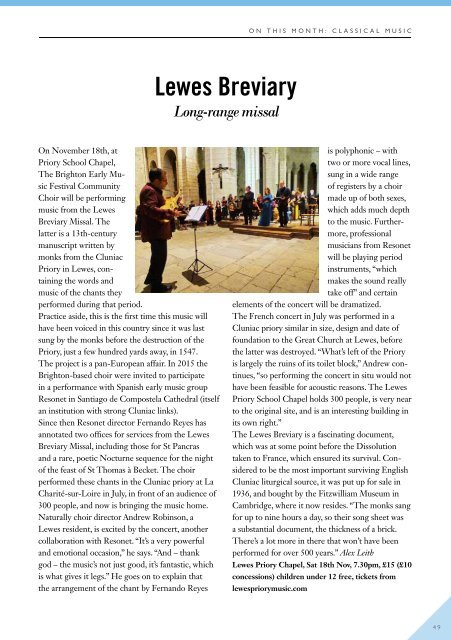Viva Lewes Issue #134 November 2017
Create successful ePaper yourself
Turn your PDF publications into a flip-book with our unique Google optimized e-Paper software.
ON THIS MONTH: CLASSICAL MUSIC<br />
<strong>Lewes</strong> Breviary<br />
Long-range missal<br />
On <strong>November</strong> 18th, at<br />
Priory School Chapel,<br />
The Brighton Early Music<br />
Festival Community<br />
Choir will be performing<br />
music from the <strong>Lewes</strong><br />
Breviary Missal. The<br />
latter is a 13th-century<br />
manuscript written by<br />
monks from the Cluniac<br />
Priory in <strong>Lewes</strong>, containing<br />
the words and<br />
music of the chants they<br />
performed during that period.<br />
Practice aside, this is the first time this music will<br />
have been voiced in this country since it was last<br />
sung by the monks before the destruction of the<br />
Priory, just a few hundred yards away, in 1547.<br />
The project is a pan-European affair. In 2015 the<br />
Brighton-based choir were invited to participate<br />
in a performance with Spanish early music group<br />
Resonet in Santiago de Compostela Cathedral (itself<br />
an institution with strong Cluniac links).<br />
Since then Resonet director Fernando Reyes has<br />
annotated two offices for services from the <strong>Lewes</strong><br />
Breviary Missal, including those for St Pancras<br />
and a rare, poetic Nocturne sequence for the night<br />
of the feast of St Thomas à Becket. The choir<br />
performed these chants in the Cluniac priory at La<br />
Charité-sur-Loire in July, in front of an audience of<br />
300 people, and now is bringing the music home.<br />
Naturally choir director Andrew Robinson, a<br />
<strong>Lewes</strong> resident, is excited by the concert, another<br />
collaboration with Resonet. “It’s a very powerful<br />
and emotional occasion,” he says. “And – thank<br />
god – the music’s not just good, it’s fantastic, which<br />
is what gives it legs.” He goes on to explain that<br />
the arrangement of the chant by Fernando Reyes<br />
is polyphonic – with<br />
two or more vocal lines,<br />
sung in a wide range<br />
of registers by a choir<br />
made up of both sexes,<br />
which adds much depth<br />
to the music. Furthermore,<br />
professional<br />
musicians from Resonet<br />
will be playing period<br />
instruments, “which<br />
makes the sound really<br />
take off” and certain<br />
elements of the concert will be dramatized.<br />
The French concert in July was performed in a<br />
Cluniac priory similar in size, design and date of<br />
foundation to the Great Church at <strong>Lewes</strong>, before<br />
the latter was destroyed. “What’s left of the Priory<br />
is largely the ruins of its toilet block,” Andrew continues,<br />
“so performing the concert in situ would not<br />
have been feasible for acoustic reasons. The <strong>Lewes</strong><br />
Priory School Chapel holds 300 people, is very near<br />
to the original site, and is an interesting building in<br />
its own right.”<br />
The <strong>Lewes</strong> Breviary is a fascinating document,<br />
which was at some point before the Dissolution<br />
taken to France, which ensured its survival. Considered<br />
to be the most important surviving English<br />
Cluniac liturgical source, it was put up for sale in<br />
1936, and bought by the Fitzwilliam Museum in<br />
Cambridge, where it now resides. “The monks sang<br />
for up to nine hours a day, so their song sheet was<br />
a substantial document, the thickness of a brick.<br />
There’s a lot more in there that won’t have been<br />
performed for over 500 years.” Alex Leith<br />
<strong>Lewes</strong> Priory Chapel, Sat 18th Nov, 7.30pm, £15 (£10<br />
concessions) children under 12 free, tickets from<br />
lewespriorymusic.com<br />
49


















